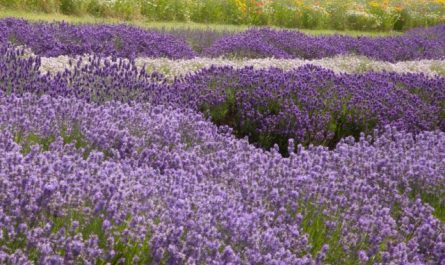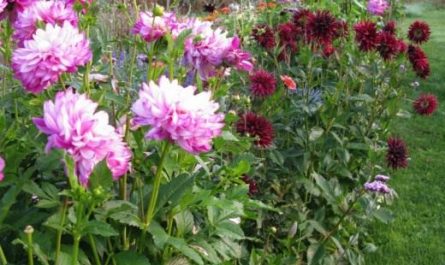Gardening in England is a national tradition that has become the hallmark of foggy Albion, despite the fact that the English were taught to create decorative landscapes by their neighbors – the French and Italians. Until the end of the 17th century, gardens in England looked like beds with aromatic herbs, vegetables and fruits. They were grown by medieval monks at monasteries and almost all ordinary residents of the kingdom, thus replenishing their food basket. Today, many English gardens founded several centuries ago are considered the best examples of landscape art. And one of them is Trentham Gardens.

Reference «Botanical»:
- Location: Stone Road Trentham, Stoke-on-Trent, Staffordshire, ST4 8AX;
- Size: 330 hectares;
- Age: 258 years old;
- Website: www.trentham.co.uk
- Feature: Is it possible to combine the “incompatible”? Two very different styles of garden design, strict “regular” and reckless “Naturgarden”, merged into a single ensemble in the territory of Trentham Gardens. What came out of it, read on.
Contents:
Revolution in gardening in England
The beginning of the end of the era of “English vegetable gardens” was marked by the creator of Versailles Andre Le Nôtre, who came to the country at the invitation of the English nobility to create several parks and gardens for the royal persons of England. And already after some half a century, the local landscape architect Lancelot Brown made a revolution in domestic gardening, having developed the concept of the English landscape garden in the form in which it exists today.
During his long creative life, he created about two hundred gardens and parks, many of which have been preserved to this day almost in their original form. Trentham Gardens is one of his many works. True, it has undergone many radical changes during its long life.

History of Trentham Gardens
Their history began in 1759 with a landscape park. It was laid out by Lancelot Brown along the banks of a lake stretching for about 1,5 km (today there are colorful meadow plantings of annuals, biennials and perennials). At that time, the lake, as well as 330 hectares of land of the future gardens, belonged to the English Duke. Much later, in 1833, another gardener-architect Charles Barry laid out in the already existing park, the so-called Italian flower gardens – an example of a landscape garden in a regular style. Unfortunately, at the beginning of the 20th century, the estate fell into disrepair and was sold. The park with a hundred and fifty-year history became public property, which, of course, did not do it any good.
Only comparatively recently, in 2004, Lancelot Brown’s brainchild was given a new lease of life by the most famous landscape designers of our time – Tom Stuart-Smith from Great Britain and Peter Oudolf from Holland. The Englishman recreated the upper part of the old Italian flower garden in a more modern form, and the Dutchman interpreted its lower part in his own way.

Works by Pieter Oudolf – Flood Meadow by the River and Floral Labyrinth
It should be noted that the Dutch architect was given a very problematic area to work on. The fact is that the local river, flooding annually, covers quite large areas of the garden with water. Therefore, Peter Oudolf’s task was also to select such plants for the flower beds of this area that would be able to withstand regular floods and quickly restore their decorative qualities in moist soil.
He coped with this task with honor, choosing a minimalist approach: impressive plantings of low varieties of molinia were diluted with colorful splashes of flowers that respect moisture. Here are astrantia, astilbe, irises and globeflowers, daylilies and clasping knotweed.
Peter Oudolf created his floral labyrinth on 55 acres, adjoining one side to the Flood Meadow, and the other to the Italian garden of Stuart-Smith. His brainchild is 32 luxurious flower beds in the style of natural gardens, which are separated from each other by narrow paths of lawn and gravel.
But if you are lucky enough to be in Trentham Gardens in late summer or early autumn, you will see the Oudolfian flower beds at their most decorative. At this time, the area really does resemble a maze – it is easy to get lost among the towering miscanthus, meadowsweets and hemp grasses.
A special pleasure is provided by a walk through the labyrinth to any of the two huge lawns at different ends of the garden. These are unique beautiful areas where you can admire and study the most diverse, but always effective and harmonious combinations of Oudolf’s color compositions. On weekends, the lawns are full of vacationers. They arrange small picnics here, “catching their breath” after walking around the neighborhood.

Italian Garden by Tom Stuart-Smith
The regular garden created in the upper part of the old Italian garden by the English landscape architect is perhaps the most “irregular” of all the “regular” ones. The classic of garden art – the Italian garden, where the chiseled forms of thuja and geometrically strict boxwood borders play the first violin, is filled with disorderly and chaotic flower beds, characteristic of the gardens of the “New Wave”, but not Italian.
Oudolf’s work surrounds the new Italian garden on all sides, the plants selected for the latter’s flower beds are purely “Oudolfian”, but at the same time his regular style remains regular. “Wild” flower beds and borders do not merge with the mixed borders of the neighboring garden due to the strict lines created by boxwood borders.
Inside, rudbeckia and hakonechloa, hemp grass and reed grass, grasshoppers and clasping knotweed grow chaotically. In addition to the ornamental grasses and cereals typical of the New Wave gardens, the architect planted heat-loving perennials inside the strict borders: dahlias, gaillardia, aeoniums and gladioli. As befits an Italian-style garden, there are many antique flowerpots. The designer planted scarlet begonia in them, emphasizing the tone of the bright perennial flowers.

What else besides plants?
Every day, hundreds of tourists from all over the world visit this pearl of English gardening, and for many years Trentham Gardens have remained a favorite place for the English to relax. They come here for the fresh air and the smell of herbs, to admire the beautiful views and take leisurely and calm walks. Interesting performances and seasonal fairs are also held here.
There is a shopping centre on the territory of the gardens, in 77 wooden houses of which there are shops, cafes, restaurants and snack bars. Here you can buy not only plants and goods for gardening, but also many other useful little things for life. And all this – in a warm and joyful atmosphere of the English village. So, if you are in good old England, be sure to drop in here!
In the meantime, check out more photos of Trentham Gardens in our photo gallery.
Trentham Gardens Photo Gallery
And what world-famous gardens have you, our readers, seen? Share your impressions in the comments to the article or on our Forum.



















